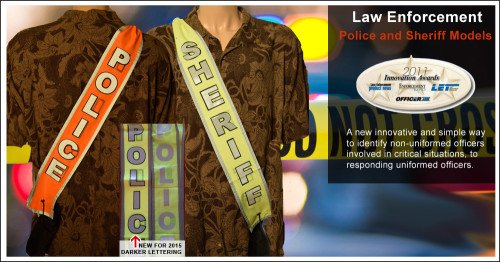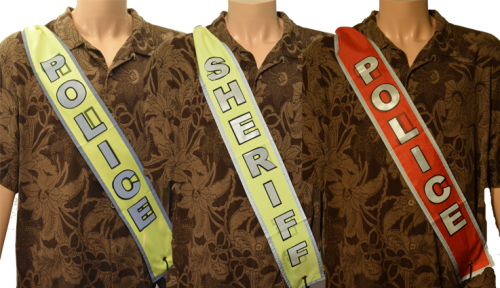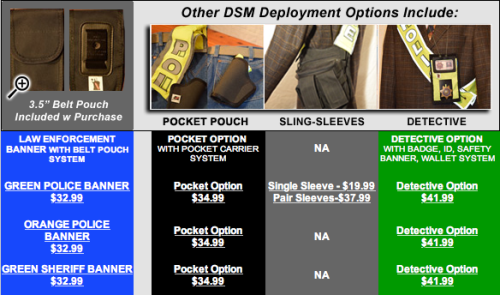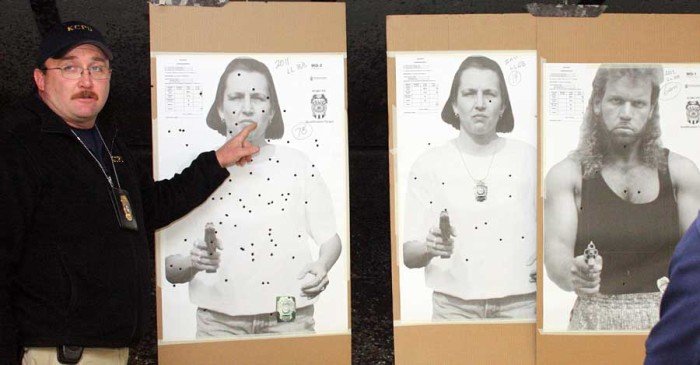
DSM “Don’t Shoot Me” Products produces high quality police, sheriff, and other safety banners for officers in an undercover or off-duty situation, who need to quickly identify themselves as law enforcement. Their safety product has reflective lettering and bright colored backgrounds to quickly draw attention to the identifying banner. These safety banners have been shown to be highly effective in identifying off-duty or undercover police officers who take police action in civilian clothing, especially in low-light situations.
UPDATE: Be sure to scroll to the bottom where there is a very nice endorsement of this product by a FBI Agent who conducted an informal test of the DSM Banner during a Division firearms training session. Agents were required to move to three shooting stations in total darkness, where they were confronted with four realistic targets at each station – good guys, no-shoot, and bad guys. The only good-guy target to not be engaged with gunfire was the one using the DSM banner.
The DSM banners are lightweight, and can be folded or rolled up to fit inside a pocket. The banners can also be carried in a nylon belt-mounted pouch. This safety banner has huge potential in properly identifying police officers in civilian clothes, and avoiding the unthinkable blue on blue accidental shooting of off-duty officers by on-duty officers who engage a subject armed with a firearm. As such, I wanted to pass along some information on this beneficial piece of law enforcement equipment.

DSM Police Safety Banners
DSM Products began in 2007 when a SWAT Sergeant realized during the major influx into Active Shooter training, there was no adequate and viable solution to identifying off-duty officers or officers in civilian clothing that had responded to assist. The DSM Safety Banner, with its bright ANSI green (looks more yellow) background and reflective lettering, was developed to provide these civilian clothed officers a near 360-degree identification. There is a bright orange background option as well.
These banners stand out both day and night, just like the traffic safety vests that officers wear when on a crash scene. The reflective borders and lettering will provide a very clear identification to the introduction of any light, making civilian clothed officers much more safe when performing duties in that dress.

The banners can be easily deployed by simply unfolding and looping the banner over the officer’s neck and one arm. Because of their lightweight and fabric type material, the safety banners can also be stored very easily and quickly in a small location.
The DSM safety banner has two distinct deployments:
- Post-Critical Incident Deployment – putting the bad guy down, seeking cover, tactically reloading and deploying the DSM Safety Banner to identify yourself to arriving law enforcement units. (The gunfight finds you mode)
- Pre-Critical Incident Deployment – Before placing yourself into a critical incident, deploy your DSM Safety Banner so your not misidentified by possible law enforcement officers on scene already. (You find the gunfight mode)
The DSM Law Enforcement Safety Banners options:

Lessons From the KCPD Badge Placement Study
As you may remember, the KCPD Badge Placement Study was conducted in 2011 and 2012 by the Kansas City, Missouri Police Department. The Firearms Unit of KCPD included various targets of plain clothed officers among the actual “threat” targets. An exact replica of the KCPD badge (with correct size) was placed on the plain clothed officer targets on the waist line and on an imaginary neck chain hanging at the “officer’s” chest.
Ultimately, the study revealed that officers were initially focusing only on the firearm when deciding to shoot. After intense training, officers learned to make split second scans of the targets to see if there was a badge or other form of identification. Accidental shootings of plain clothed officers dropped significantly, and were particularly reduced for targets wearing badges at chest level – on neck chains. This led to KCPD issuing a department-wide mandate for officers in civilian clothes to wear badges around their neck and not on their waist band.

Despite this study and training model being a great benefit to plain clothed and uniformed officers alike, the placement of a badge still does not provide 360-degree identification, and is still hindered in low-light conditions. The DSM Police Safety Banner seeks to fill that void with near 360-degree identification in highly reflective material.
The Effects of a Blue-on-Blue Shooting
A blue-on-blue shooting is devastating in many ways. The officer who is shot could suffer life-altering injuries or death. Their family will suffer along with their loved one. The officer who shot the other officer will undoubtedly suffer immense psychological trauma, and a strong sense of isolation.
Officers are expected to get things right, and shooting another officer is a tremendous blow to the trust officers need to function. Many officers who shoot another officer, leave police work within a short time, and some have even ended their lives over the mistake.
The Department suffers with the loss of multiple officers – the injured or killed officer, and the officer who fired the shot. Entire shifts can be effected as officers inevitably take sides of who was more at fault for the shooting. If the shooting crosses agency lines, a very real possibility in an active shooter or critical incident with multiple agencies responding, the effects can be even worse. Entire departments end relationships, and in some cases open hostilities emerge.
Final Thoughts
There is no doubt the DSM Police Safety Banner can provide a superior form of identification for officers in civilian clothing. In addition to wearing a badge at chest level, the DSM identification banner is a quick reference identification in both daylight and low-light situations. These banners should be seriously considered by any agency.
BlueSheepDog is a strong proponent of officers carrying their firearms and handcuffs at all times when off-duty. We would also highly recommend that officers purchase some form of positive identification in the event they have to take action during a time when they are in civilian dress. The DSM Police Safety Banner is a great consideration for that purpose.
TESTIMONIAL
Mike,
It was a real pleasure to speak with you earlier. As I mentioned over the phone, prior to transferring here to Texas I was a Firearms Instructor at the ***** Division range at ******. Our Primary FI, *******, had purchased your banner for the agents in our division – a decision that was partially motivated by the blue-on-blue shooting on Long Island in 2011 that claimed the life of ATF SA Capano.
**** did not force our agents to take the banner but instead made them available to anyone who wanted one. During one of our quarterly night fire shoots that mandates a flashlight familiarization, **** approved a course of fire I devised that incorporated your police banner. The overall goal of this course of fire was to reinforce to our agents the inherent difficulty of identifying shoot/no-shoot scenarios when faced with real world stressors such as complete darkness, increased heart rate, and equipment manipulation. We did not keep any official records – this was just a teaching point. Three separate shooting stations were set up on our range approximately 10 yards apart. The firing point for each station was marked by an orange cone that placed the shooter at approximately 7 yards from their targets. Each station featured 4 full torso realistic targets comprised of a mixture of hostile attackers, uniformed officers, and plainclothes agents wearing badges roughly the size of the *** agent shield. Each station also featured one steel target. On the last target of the last station, I threaded your police banner through cuts I made near the shoulder and waist of a plainclothes agent target.
The shooters were sequestered indoors and brought out one at a time to run through the course of fire in total nighttime darkness, which necessitated the use of either a flashlight or weapon mounted light. The shooters were instructed to load their magazines for duty and were made ready at the 50 yard line of the range. Each shooter received the following instruction: You are responding to a gun battle. You will run forward and locate the orange cone which will mark your first firing point. There are a total of three firing points moving left to right. In each firing point you must first locate and engage the steel plate with two confirmed hits before engaging any other threat. Each threat target must be engaged with at least two rounds.
The darkness – not knowing what to expect downrange and waiting for your turn – as well as the initial sprint to the first station served to get the shooter’s heart rate elevated. The mandate to first locate and successfully hit the steel with two shots forced the shooter to make proper use of their light in conjunction with their sights and served to reinforce weapons manipulation and accuracy. During the course of fire I observed what has been previously documented during training scenarios of this type: good guys invariably get shot…with one exception. I did not observe a single shooter engage the last target wearing your police banner. Indeed, the most common reaction I observed when a shooter illuminated the reflective banner was to immediately bring their weapon to a retracted or cover position. As a teaching point this course of fire was a great success. It really drove the point home that wearing this banner increases the odds of surviving an armed confrontation.
I hope this email finds you well and, as always, be safe.
Greg says
Can you make a sash that says “School Safety” in a quick deployment pouch?
Aaron says
Greg BlueSheepdog does not make of this product, but I’ll pass on your request to the DSM customer service representatives and see what I can find out.
Aaron says
Greg I would contact the DSM Safety customer service and talk with them. I believe they are either in the process of adding this, or willing to entertain an order.
dsmsafety@aol.com
775-250-5523
Mason Wetzel says
can we get a discount for church security
Aaron says
Mason BlueSheepdog is not the manufacturer or distributor of this product. However, we have found their Customer Service very helpful. Here is their contact information:
dsmsafety@aol.com
775-250-5523